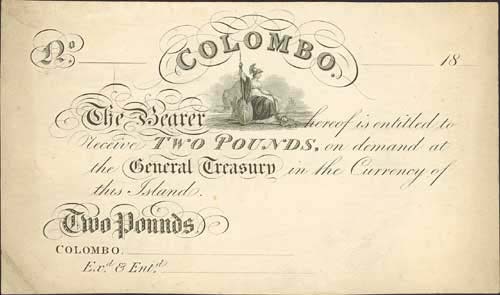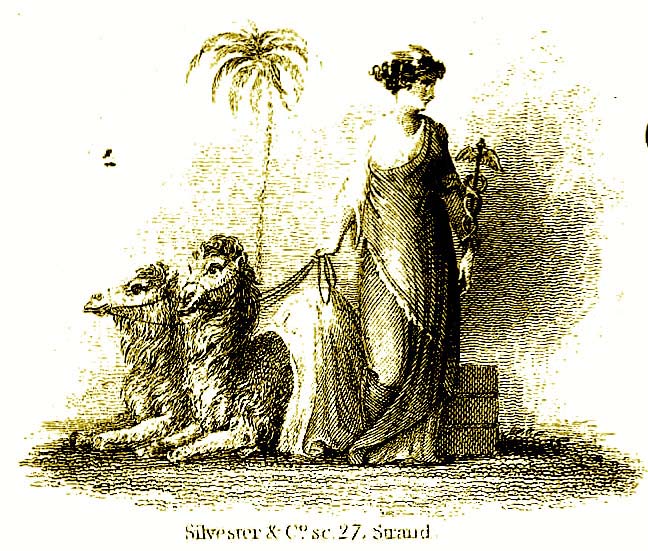British Ceylon
Colombo - Pounds Sterling - 1827
By Regulation 8 of 1827 £ 90.000 paper currency was issued
in the denominations of 1, 2, 5, 10, 20, 25, and 50.
Below specimen Proofs of Pounds Sterling Currency Notes with engraving of Britannia
which were used for the 1827 issue in Colombo.
| Denomination | : 1 £ |
| English | : One Pound |
| Size | : 205 x 124 mm |
| Date | : 18(27) |
| Status | : Proof on Card |
| Vignette | : Left Middle |
| Detail | : Caparison elephant to right, Two Coconut palms behind |
| 
|
| KM-lk# Unlisted
|
| Denomination | : 2 £ |
| English | : Two Pounds |
| Size | : 205 x 121 mm |
| Date | : 18(27) |
| Status | : Proof on Card |
| Vignette | : Upper Middle |
| Detail | : Wild elephant to left. Ship to right |
| 
|
| KM-lk# Unlisted
|
Front : Britannia with helmet seated, Shield
with Union Jack on side, Spear in right hand,
To right No ..... COLOMBO in curve ...... 18...
The Bearer is entitled to receive ONE/TWO POUND on demand
at the General Treasury in the Currency of the Island.
Exd & Entd .....
Back : Blank ?
WaterMark : Need to Findout
Printed : Silvester & Co. sc 27, Strand, London.
The size of note was guessed to be 8 inch by 5 inch typical of notes of that Era.
Needs confirmation.
The 2011 Spink Auction
of 19th Century Ceylon Notes listed these Specimen Proofs on card of
Pound 1 and
Pound 2
with vignettes of seated helmeted Britannia.
On the day of this Spink Auction, the anonymous owner of collection cancelled it.
These two Specimens are described by Virginia Hewitt of British Museum in
article
there were also attempts to give the Ceylon Treasury notes some local
colour. The one pound and two pound notes carried vignettes of
Britannia, each with an elephant in the background; the image on the
one pound note also included a pagoda and distant palm trees.
The Pagoda is the Relic Casket on Caparison Elephant, and
the Palm Trees are in fact Coconut palms.
Also says that she is
not aware of any surviving issued notes of this series, several
unissued examples and proofs indicate what they would have been
like. The vignettes on the notes were the work of
Silvester, a London engraver who produced notes for many private
local banks in towns throughout Britain. Much of the paper money used
in her colonies was printed in Britain, and it is perhaps to be
expected that the imagery drew heavily on the iconography used on
British banknotes.
The British Museum does not have any specimen of this series. She
published the vignette by Silvester & Co sc 27, Strand
on the Five Pound note from the collection of William L. S. Barrett.
She describes vignette as
 featuring a graceful female allegorical figure, with little wings
symbolising communication in her hair, and holding a caduceus, the
winged staff indicating that she is a messenger offering peace,
protection and health. Include a large package, suggesting for Ceylon
where profit earned through exports was clearly appealing to her
colonial masters.
featuring a graceful female allegorical figure, with little wings
symbolising communication in her hair, and holding a caduceus, the
winged staff indicating that she is a messenger offering peace,
protection and health. Include a large package, suggesting for Ceylon
where profit earned through exports was clearly appealing to her
colonial masters.
The palm tree appears again on the five pound note, but this time the
female allegory is accompanied not by an elephant, but by two camels
kneeling quietly while she holds their reins. It is a delightful but
surprising scene, not least because the camel is not indigenous to
Ceylon. Unfortunately we do not know who chose this design, but we may
suspect that these creatures were the engraver's attempt to find what
he thought was an appropriate emblem for South Asia.
These Specimens do not have the value of the note in Sinhala and
Thamil which has been always present since 1785. The Sinhala and
Thamil were probably hand stamped like the Ceylon Rix Dollar
notes issued from 1809-1814 and printed by same
Silvester, and explain their absence in these Specimens. It is
unlikely that in this series alone the notes were issued in English
only.
I was curious why the identity
Silvester & Co sc 27 Strand seen below the
vignette on the £5 engraving is not visible on these two
specimens. However looking under high magnification of printed Auction
catalog and I could see it faintly and barely resolved.
Text from
Paper Money for Ceylon Printed in England by V. H. Hewitt, Pages 255-272
Origin, evolution, and circulation of foreign coins in the Indian Ocean.
Proceedings of the numismatic workshop : Colombo, 1994 September 8-10
edited by Osmund Bopearachchi and D. P. M. Weerakkody
Images at 62 dpi displayed at 50 dpi.
Please help if you have specimens of this series or know where
specimens exist, or have any reference information on these elusive
notes. Comments also welcome.
Please contact kavan @ gmail.com if you can Help. Thanks.


 featuring a graceful female allegorical figure, with little wings
symbolising communication in her hair, and holding a caduceus, the
winged staff indicating that she is a messenger offering peace,
protection and health. Include a large package, suggesting for Ceylon
where profit earned through exports was clearly appealing to her
colonial masters.
featuring a graceful female allegorical figure, with little wings
symbolising communication in her hair, and holding a caduceus, the
winged staff indicating that she is a messenger offering peace,
protection and health. Include a large package, suggesting for Ceylon
where profit earned through exports was clearly appealing to her
colonial masters.